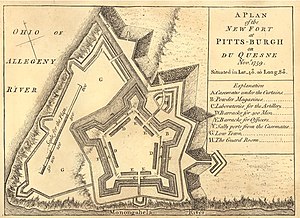Siege of Fort Pitt
| Siege of Fort Pitt | |||||||
|---|---|---|---|---|---|---|---|
| Part of Pontiac's Rebellion | |||||||
 "A Plan of the New Fort at Pitts-Burgh", drawn by cartographer John Rocque and published in 1765. |
|||||||
|
|||||||
| Belligerents | |||||||
| Ohio Country natives | Great Britain | ||||||
| Commanders and leaders | |||||||
| Guyasuta | Simeon Ecuyer William Trent |
||||||
The Siege of Fort Pitt took place during June and July 1763 in what is now the city of Pittsburgh, Pennsylvania, United States. The siege was a part of Pontiac's War, an effort by Native Americans to remove the British from the Ohio Country and Allegheny Plateau after they refused to honor their promises and treaties to leave voluntarily after the defeat of the French. The Native American efforts of diplomacy, and by siege, to remove the British from Fort Pitt ultimately failed. This event is best known for the use of biological warfare, where the British gave items from a smallpox infirmary as gifts to Native American emissaries with the hope of spreading the deadly disease to nearby tribes.
Fort Pitt was built in 1758 during the French and Indian War, on the site of what was previously Fort Duquesne in what is now the city of Pittsburgh, Pennsylvania, United States. The French abandoned and destroyed Fort Duquesne in November 1758 with the approach of General John Forbes's expedition. The Forbes expedition was successful in part because of the Treaty of Easton, in which area American Indians agreed to end their alliance with the French. American Indians—primarily the Six Nations, Delawares and Shawnees—made this agreement with the understanding that the British would leave the area after their war with the French. The hostilities between the French and English declined significantly after 1760, followed by a final cessation of hostilities and the formal surrender of the French at the Treaty of Paris in February 1763. Instead of leaving the territory west of the Appalachian Mountains as they had agreed, the British remained on Native lands and reinforced their forts while settlers continued to push westward.
...
Wikipedia
